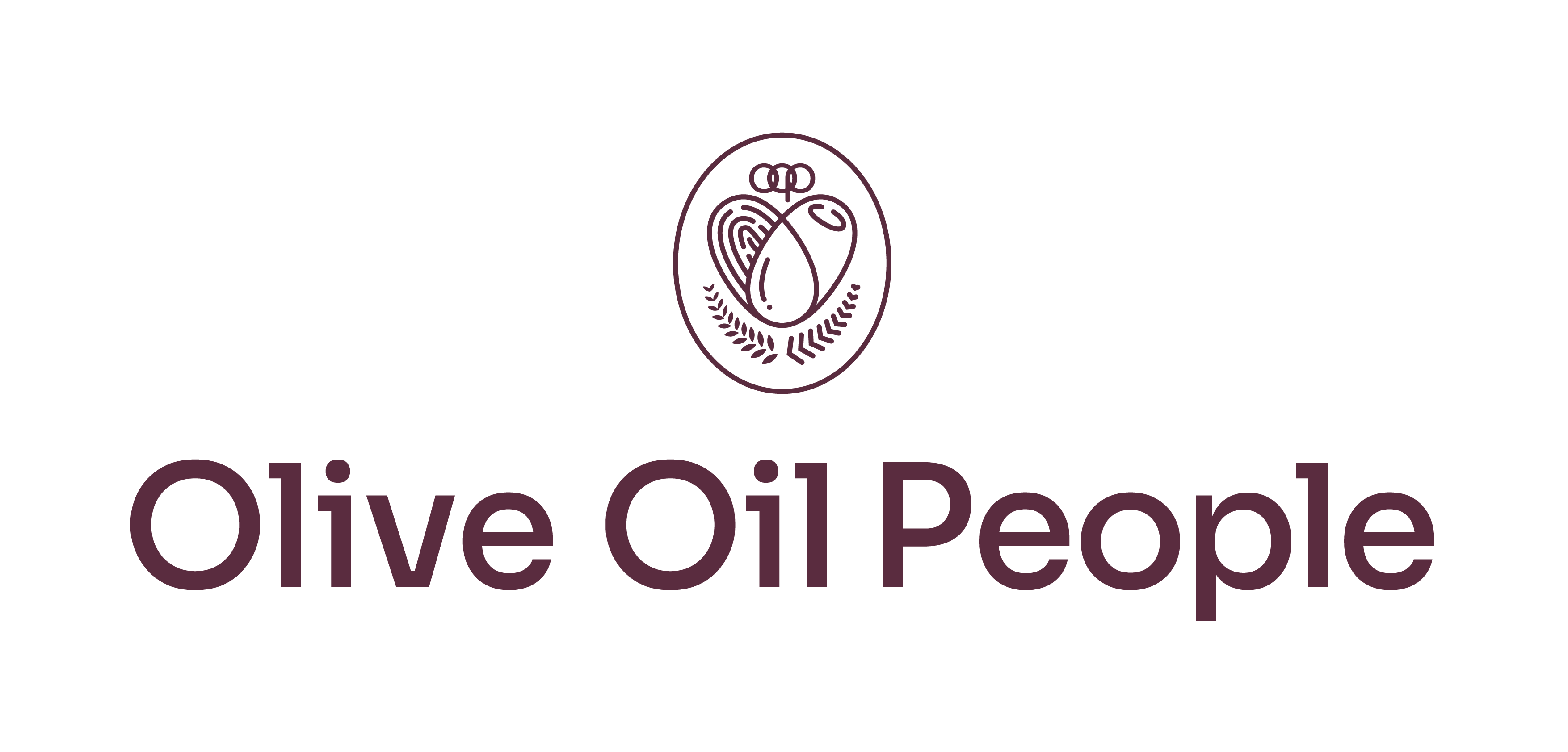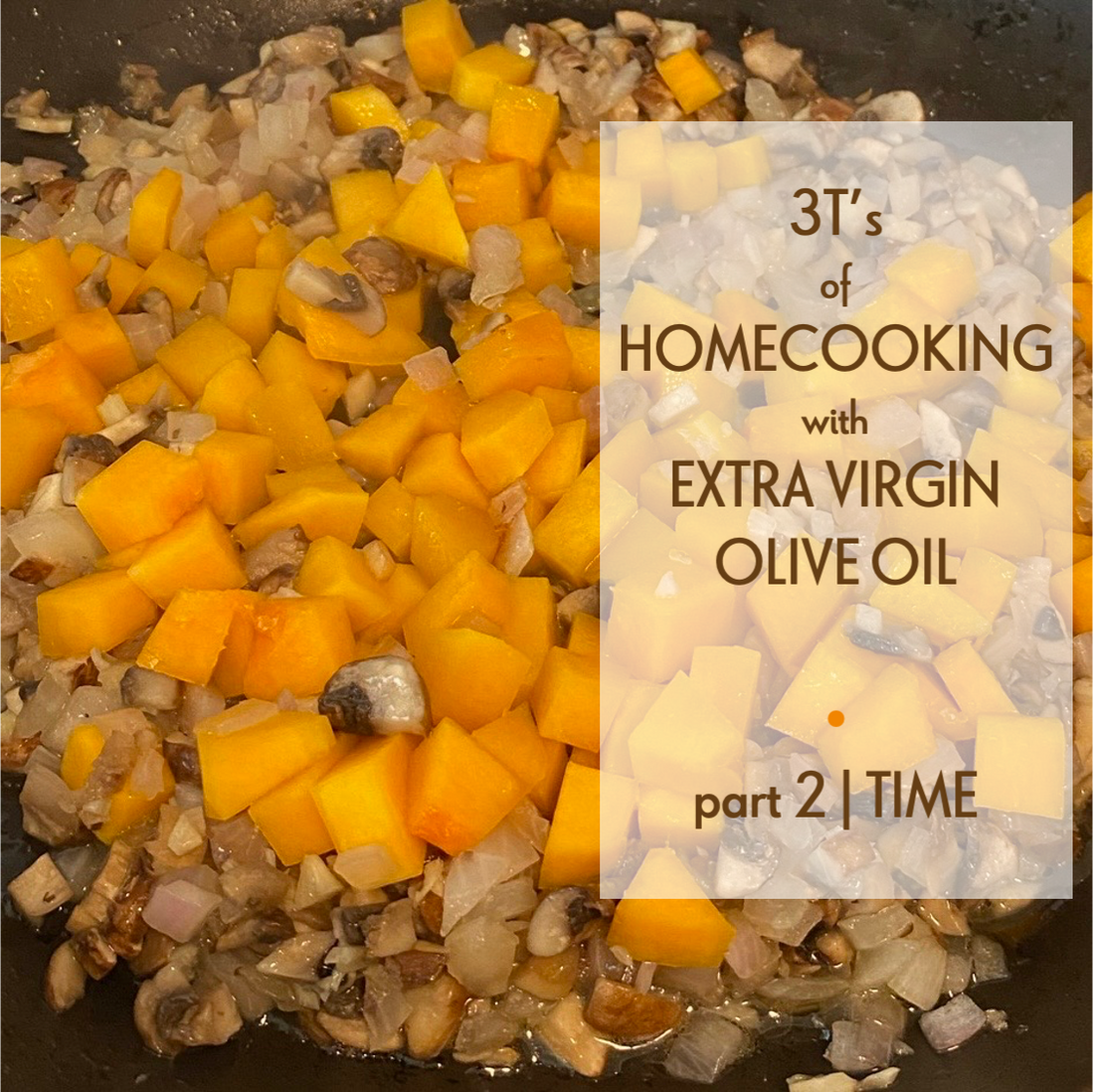Learn why observing certain time-related tips can enhance the taste and health benefits of extra virgin olive oil (EVOO)
In this second part of a three-part series blog post divided into Temperature, Time and Taste, we discuss how Time plays an important role in our pursuit of optimal taste and health benefits when cooking with and consuming extra virgin olive oil. As with the previous article about Temperature, you will find research-based findings and pick up some easy tips. Also watch out for an equally fascinating Part 3, where we will share about the exquisite tastes of extra virgin olive oils.
Last Updated: 29 July 2021 | Cooking/Culinary
Time and Extra Virgin Olive Oil
Rarely do we think of time as an ingredient. When cooking with and consuming extra virgin olive oil, time (and timing) can be of the essence. By combining knowledge of harvest seasons in various growing regions, how EVOO behaves when put through cooking durations and using some time-saving tips, we can further enhance EVOO’s health and taste benefits.

Image by Olive Oil People
Freshness of extra virgin olive oil matters to taste and health
Extra virgin olive oil is the natural “juice” of the olive fruit that goes through minimal processing apart from washing, pressing and decanting. Probably an overly simplistic analogy, it is not unlike more familiar fresh fruit juices which over time and exposure to the elements would eventually diminish in flavours and inherent health properties. Knowing when olive harvest seasons happen plays a part in helping us be more informed when buying extra virgin olive oil because new harvest oils are fresher, taste better and in some cases healthier.
Harvest timings of different olive-growing regions offer freshness and taste variety all-year-round
Generally, olives bloom in spring and continue to ripen throughout summer and are harvested in the early fall. All olives start out green and then gradually become rosy and finally almost black. When it comes to producing olive oil, the degree of ripeness matters a lot. Riper olives yield more oil and greener olives give us more complex flavours and higher levels of healthy phenolic content. Depending on the climate, olive variety and purpose for the olives (such as for table olives or making oil), olives are generally picked during either of the two broad periods of the agricultural year (olive harvest seasons). They coincide with October through January in traditional olive-growing regions around the Mediterranean basin, and May through July in the Southern hemisphere regions like New Zealand. There are of course exceptions to this general rule in other regions and countries. All good EVOO producers label harvest or bottling dates along with best-by dates, typically with 18 months to two years between them. Look for the harvest date the next time you shop for extra virgin olive oil.
There is a lot to discover gastronomically when opening up our home pantries to extra virgin olive oils from different growing regions. As with wines, a Sauvignon Blanc or Pinot Noir from New Zealand can offer a different gustatory experience when compared with those from France. But more on this later in part 3 of this blog-series, when we discuss the topic of Taste when home-cooking with extra virgin olive oil.

Image by Olive Oil People
Buying extra virgin olive oil directly from New Zealand olive growers offers more than just counter-seasonal freshness
In Singapore, where it’s easier to find olive oils from traditional growing regions such as Spain or Italy, extra virgin olive oil from New Zealand offers counter-seasonal freshness. When most olive oils have sat on your grocers’ shelves or warehouses since January, fresh new harvest EVOOs from New Zealand arrive on Singapore’s shores around September. Additionally, if you buy directly EVOO from growers, the EVOO would be fresher owing to a shorter supply chain and possibly more thoughtful handling and storage practices in Singapore’s hot and humid climate. As an example, Olive Oil People store all their EVOO in a professional wine cellar storage from where their final customer orders are fulfilled while offering low minimum quantities to their wholesale retail partners, so as to reduce the amount of time the bottles sit on grocery shelves.
Extra virgin olive oil is not only heat-stable for cooking, it remains healthy when cooked longer
In part 1 of this blog series, we mentioned about heat stability of olive oil, its usage in frying and also expressed our advocacy for Singapore’s My Healthy Plate campaign which highlights olive oil as one of the healthier oils for cooking; replacement for oils or fats that contain higher saturated fatty acids(SFA) such as butter or coconut oil. Olive oil, especially extra virgin olive oil contains primarily monounsaturated fatty acids(MUFA) which sets it apart as even healthier when compared to other unsaturated vegetable oils that are more commonly high in polyunsaturated fatty acids(PUFA). Furthermore, owing to the high composition of MUFA, extra virgin olive oil has been shown to be even more stable than other higher MUFA oils like canola or peanut in high-heat cooking temperatures.
A brief but important detour is both useful and timely at this juncture to further understand what exactly makes EVOO healthy in order to better appreciate the effects of cooking time, and time’s interaction with temperature.
The major and minor components of extra virgin olive oil’s health and taste effects
Health protective effects of olive oil is based on its chemical composition, which can be divided into major and minor components. The major component refers to the triglycerides which constitute 98% of the total weight of olive oil. Olive oil’s MUFA of which are primarily oleic acid, the basic fatty acid of olive oil, ranges between 55-83% depending on region, varietal and growing conditions. Olive oil’s MUFA with its high oleic acid content has been shown in several studies to be beneficial for preventing cardiovascular diseases and reducing low-density lipoprotein (LDL) cholesterol level or as we know it, the bad cholesterol. Most compelling among these studies is the PREDIMED study which remains the largest dietary intervention trial to assess the effects of the olive oil rich Mediterranean diet on cardiovascular disease prevention.
The remaining 2% while minor in proportion, if far from negligible in its health effects. This 2% is where we find the antioxidant and anti-inflammatory effects of olive oil, particularly the phenolic compounds. The total phenolic content (TPC) can be significantly correlated to the taste intensity of extra virgin olive oil.
Cooking time has little impact on extra virgin olive oil’s taste or total phenolic content
In a relatively unique study of domestic sautéing with EVOO simulating cooking conditions of home kitchens (making it more realistic than testing in lab conditions), the researchers found that cooking foods longer in EVOO did not significantly alter the TPC. While temperature was found to be a more significant factor in TPC depletion, heating EVOO at 180°C (a standard frying temperature) for 1 hour or 5 hours made no difference. The conclusion drawn from the study was the total polyphenols and values were still higher than the 250mg/kg of hydroxytyrosol, tyrosol and derivatives necessary to inhibit LDL cholesterol oxidation, when cooking at moderate temperatures for longer.
This bodes well for those of us who are still adjusting to cooking at higher temperatures with EVOO. Not only is EVOO very stable for various heat-applied cooking methods, cooking longer does not compromise the health and taste benefits we expect to enjoy from the EVOO.

Image and Instagram post by Olive Oil People
Save time with infused extra virgin olive oil
It is hard to avoid the topic of saving time when most of our busy lives demand some shortcuts in meal preparations. Quick meals can be made healthier and tastier when we have a couple of bottles of high quality infused EVOO handy.
Versatile flavours of infused extra virgin olive oils
Buy infused olive oils that complement your preferred ingredients and most frequently consumed cuisine type. Even on days when whipping up a home-cooked meal is a challenge, infused EVOO can enhance the taste and make your favourite take-outs healthier. Infused EVOO’s work marvellously in simple cooking methods as in dressings and sauces and even as a marinade.
Lemon infused EVOOs are particularly versatile in both savoury and sweet dishes, for example, simply drizzled over steamed vegetables or over crepes and ice-creams. Porcini mushroom infused EVOO adds a surprising umami twist to some Asian-inspired dishes like tofu and tempeh dishes. Why not swap usual chili sauces for a good infused chili EVOO that can be used frequently, if your palate leans towards spicy foods. Smoked paprika infused EVOOs can add a meaty flavour to grains and quinoa. There are countless easy possibilities and combinations that we will revisit in the third part of this blog series.
In a nutshell
Choosing to buy EVOO according to the different olive harvest seasons of growing regions, opens up our pantries to include not only fresher EVOO’s all-year round, it allows us to explore a greater variety of taste profiles unique to each growing region. Cooking food in EVOO for a longer time in standard temperatures does not deplete the health and taste components of EVOO, allowing us to optimize the expected benefits of EVOO. Infused extra virgin olive oils make great time-savers in our busy lives while adding nutrition and flavours to quick home-cooked or take-out meals.
Look out for Part 3 of this three-part series blog post by following us on Instagram (@oliveoilpeople) when we announce.
Author's note:
our blog posts are not meant to replace your physician’s advice. However, we do cross-reference facts and data points with expert sources, observations and research publications, where available. All photos by Olive Oil People.


